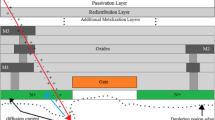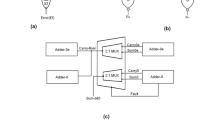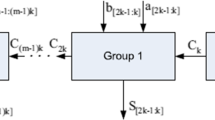Abstract
This work proposes the use of analog majority gates to implement combinational circuits that are intrinsically tolerant to transient faults. A new type of voter circuit, that uses some knowledge from the analog design arena is proposed, together with a new mapping approach to implement circuits given their input/output table. This new mapping approach is shown to compare favorably against a classic mapping. The implementation and validation of an adder circuit, using conventional triple modular redundancy (TMR), the classic mapping, and the proposed solution are analyzed, in order to confirm that the shown technique is indeed fault tolerant, and has advantages in terms of area and performance when compared to TMR. Finally, implementations of a subset of the ISCAS 85 benchmark circuits using TMR with the analog voter and the proposed approach are compared and the results analyzed.








Similar content being viewed by others
References
Brglez F, Fujiwara H (1985) A neutral netlist of 10 combinational benchmark circuits and a target translator in Fortran. In: Proceedings of the 1985 IEEE International Symposium on Circuits and Systems (ISCAS 85), 5–7 June 1985. IEEE Press, Piscataway, pp 695–698
Dodd PE et al (2004) Production and propagation of single-event transients in high-speed digital logic ICs. In: IEEE Transactions on Nuclear Science, vol 51, no 6, part 2, December. IEEE Computer Society, Los Alamitos, pp 3278–3284
Dolev S, Haviv YA (2006) Self-stabilizing microprocessor: analysing and overcoming soft errors. In: IEEE Transactions on Computers, vol 55, no 4, April. IEEE Computer Society, New York, pp 385–399
Eaton P, Mavis D, Avery K, Sibley M, Gadlage M, Turfingler T (2004) SET pulse width measurements using a variable temporal latch technique. IEEE Transactions on Nuclear Science, vol 51, no 6, part 2, December, IEEE Computer Society, Los Alamitos, pp 3365–3368
Heijmen T (2002) Radiation induced soft errors in digital circuits: a literature survey, report 2002/828, August. Philips Electronics National Laboratory, Eindhoven
Hurst SL (1978) The logical processing of digital signals. Crane, New York
Johnson BW (1994) Design and analysis of fault tolerant digital systems: solutions manual. Addison-Wesley, Reading
Lisboa CA, Schüler E, Carro L (2005) Going beyond TMR for protection against multiple faults. In: Proceedings of the 18th Symposium on Integrated Circuits and Systems Design, SBCCI 2005, 4–7 September 2005. Sociedade Brasileira de Computação, Florianópolis, pp 80–85
Messenger GC (1982) Collection of charge on junction nodes from ion tracks. IEEE Transactions on Nuclear Science, vol NS-29, no 6, December, IEEE Computer Society, Los Alamitos, pp 2024–2031
Michels Á, Petroli L, Lisboa CAL, Kastensmidt F, Carro L (2006) SET fault tolerant combinational circuits based on majority logic. In: Proceedings of the 21st IEEE International Symposium on Defect and Fault Tolerance in VLSI Systems, DFT 2006, October 2006. IEEE Computer Society, Los Alamitos, pp 345–352
Mikkola E, Vermeire B, Barnaby HJ, Parks, HG, Borhani K (2004) SET Tolerant CMOS comparator. IEEE Transactions on Nuclear Science, vol 51, no 6, part 2, December, IEEE Computer Society, Los Alamitos, pp 3609–3614
Nicolaidis M (1999) Time redundancy based soft-error tolerance to rescue nanometer technologies. In: Proceedings of the 17th IEEE VLSI Test Symposium, VTS 1999. IEEE Computer Society, Washington, DC, pp 86–94
Predictive Technology Model (2007) Predictive Technology Model web site: http://www.eas.asu.edu/~ptm
Rossi D, Omana Mm Toma F, Metra C (2005) Multiple transient faults in logic: an issue for next generation ICs? In: Proceedings of the 20th IEEE International Symposium on Defect and Fault Tolerance in VLSI Systems, DFT 2005, 3–5 October 2005. IEEE Computer Society, Monterey, pp 352–360
Sangiovanni-Vicentelli S et al SIS (1992) A system for sequential circuit synthesis. http://www.eecs.berkeley.edu/Pubs/TechRpts/1992/ERL-92-41.pdf
Schüler E, Carro L (2005) Reliable circuits design using analog components. In: Proceedings of the 11th Annual IEEE International Mixed-Signals Testing Workshop, IMSTW 2005, vol 1, 27–29 June 2005. IEEE Computer Society, Cannes, pp 166–170
Semiconductor Industry Association (2006) International technology roadmap for semiconductors, ITRS 2005. http://www.itrs.net/Links/2005ITRS/Home2005.htm. Accessed May 25, 2007
Srinivasan GR (1996) Modeling the cosmic-ray-induced soft-error rate in ICs: an overview. IBM J R&D 40(1):77–90
Synopsis (2007) Synopsis Web site: http://www.synopsys.com/products/mixedsignal/hspice/hspice.html
Acknowledgment
The authors would like to thank Álisson Michels, Cristiano Lazzari, and Simone Bavaresco for their help in the learning process of different tools.
Author information
Authors and Affiliations
Corresponding author
Additional information
Responsible Editor: N. A. Touba
Rights and permissions
About this article
Cite this article
Petroli, L., Lisboa, C.A.L., Kastensmidt, F.L. et al. Majority Logic Mapping for Soft Error Dependability. J Electron Test 24, 83–92 (2008). https://doi.org/10.1007/s10836-007-5044-0
Received:
Accepted:
Published:
Issue Date:
DOI: https://doi.org/10.1007/s10836-007-5044-0




